Performance Evaluation of 5G Access Technologies and SDN Transport Network on an NS3 Simulator †
Abstract
1. Introduction
- an extensive evaluation of radio access technologies in enhanced Mobile BroadBand (eMBB) scenarios;
- an in-depth study of the impact that the flexibility introduced by the SDN has in the transport segment;
- a discussion on the benefits of system integration of a network simulation able to consider complete end-to-end 5G services.
2. Reference Scenario
2.1. Radio Access Network
- LTE model, which includes the LTE Radio Protocol Stack (PHY, MAC, RLC, PDCP and RRC), that is installed on mobile user equipment and eNodeB and that simulates the LTE radio access;
- EPC (Evolved Packet Core) model, which includes the S1-U Protocol Stack (GTP over UDP/IP), that is installed on the network nodes of the core part of the LTE architecture (SGW, PGW and MME), and partially on the radio access nodes to the network (eNodeB); this model allows to simulate each EPC component of the cellular network and to test the IP connectivity of a mobile user connected to the Internet (for example with a simulated server connected to a network outside the LTE one).
2.2. Transport Network
2.3. Core Network
3. Simulated Scenario
3.1. Radio Access Network
- a single tri-sectoral macrocell located in the center of a square simulation area is considered;
- the macrocell eNodeB radio access technology is based on a Non-Standalone 5G configuration for the eMBB scenario and on a traditional 4G network configuration for the Legacy LTE scenario;
- the implemented 5G physical layer is inspired by the preliminary 5G New Radio indication [22], i.e., the 256-QAM modulation for the DownLink and 64-QAM for the UpLink;
- simulation scenarios are composed by 1, 10 and 100 end-users randomly deployed within the simulated area;
- for each scenario, end-users start the simulation by automatically connecting to the corresponding sector of eNodeB, through idle mode cell selection procedures; during the simulation, protocols and techniques for accessing will depend on the specific radio access technology used by each considered scenario;
- end-users leverage a 15 MHz band LTE channel around the carrier frequency of 2.160 GHz in both eMBB and Legacy LTE scenarios;
- additional two elements are included in the system simulation, i.e., the SGW and PGW nodes according to the LTE network protocol, which simulates the wired elements of the cellular network architecture. These two additional network nodes are needed to measure the end-to-end performance of the communication system, in addition to the radio interface.
3.2. Transport Network
- network topology discovery;
- ARP handler;
- flow routing procedure.
3.2.1. Network Topology Discovery
3.2.2. ARP Handler
- the SDN controller knows the MAC address of the destination host;
- the SDN controller has no information about the destination host.
3.2.3. Flow Routing Procedure
- Shortest Path Routing (SPR): forwarding based on the IP destination prefix and paths computed according to a Shortest Path rule;
- Vertical-Aware Routing (VAR): forwarding based on IP source/destination address of servers, respectively for download/upload, and paths computed according to k-shortest paths and different path weights.
| Algorithm 1 Flow routing procedure pseudo code. |
| Require: A network graph: , current flow , table of policies |
| 1: if then |
| 2: |
| 3: |
| 4: k_shortest_paths(.src,.dst,) |
| 5: Initialize() |
| 6: while do ▹ Population of |
| 7: if then |
| 8: |
| 9: while do |
| 10: Port |
| 11: .add |
| 12: j++; |
| 13: end while |
| 14: end if |
| 15: i++; |
| 16: end while |
| 17: while do ▹ Flow Rules Installation on OF switches |
| 18: |
| 19: |
| 20: while do |
| 21: install_flow_rule |
| 22: end while |
| 23: end while |
| 24: else |
| 25: install_IP-dest_rules |
| 26: end if |
| 27: return |
4. Simulation Results
4.1. Radio Access Technology Gain
- Throughput (TH): total received bits over to the total receiving time interval.
- Packet Delivery Ratio (PDR): ratio between the number of correctly received packets and the number of related transmitted ones.
- Delay: end-to-end delay between the transmitting and the receiving of a data packet.
- Jitter: variation of the end-to-end delay between packets belonging to the same data flow.
- RAN Throughput (): Throughput measured by the eNodeB and given by the sum of the Throughput () measured by all the end-users attached to this one.
- Radio Access Throughput Gain (): ratio between the RAN Throughput () obtained in the eMBB scenario and the RAN Throughput obtained in the legacy LTE, by simulations based on the same network parameters.
- the bit-rate offered to the network layer by the application layer, is higher than the threshold of maximum traffic delivered by the network;
- ten simulation runs were carried out for each network configuration, by varying the random position of the end-users within the considered area, in order to obtain a statistic of the network performance varying the end-users positions;
- the application uses UDP as transport protocol.
- the eNodeB is able to communicate always and with all the end-users deployed in the test area (no packet loss): the simulation parameter settings, used to create the different scenarios, are reliable and adequate to avoid a non-in-coverage end-user SINR level.
4.2. Transport Efficiency
- Alternative Paths (AP), where are considered path A and path C with equal weights;
- Load Balancing (LB), where all paths are equally considered;
- Weighted Paths (WP), where path A and path B are considered, but with double weights for B.
5. Conclusions and Future Works
Author Contributions
Funding
Conflicts of Interest
References
- Andrews, J.G.; Buzzi, S.; Choi, W.; Hanly, S.V.; Lozano, A.; Soong, A.C.K.; Zhang, J.C. What Will 5G Be? IEEE J. Sel. Areas Commun. 2014, 32, 1065–1082. [Google Scholar] [CrossRef]
- Settembre, M. Towards a hyper-connected world. In Proceedings of the 2012 15th International Telecommunications Network Strategy and Planning Symposium (NETWORKS), Rome, Italy, 15–18 October 2012; pp. 1–5. [Google Scholar]
- Geng, W.; Talwar, S.; Johnsson, K.; Himayat, N.; Johnson, K. M2M: From Mobile to Embedded Internet. IEEE Commun. Mag. 2011, 49, 36–43. [Google Scholar] [CrossRef]
- Salvo, P.; Cuomo, F.; Baiocchi, A.; Rubin, I. Investigating VANET dissemination protocols performance under high throughput conditions. Veh. Commun. 2015, 2, 185–194. [Google Scholar] [CrossRef]
- Kostrzewski, M.; Varjan, P.; Gnap, J. Solutions Dedicated to Internal Logistics 4.0. In Sustainable Logistics and Production in Industry 4.0; Grzybowska, K., Awasthi, A., Sawhney, R., Eds.; Springer: Cham, Switzerland, 2020; Chapter 14; pp. 243–262. [Google Scholar]
- Sun, S.; Gong, L.; Rong, B.; Lu, K. An Intelligent Framework for 5G Heterogeneous Networks. IEEE Commun. Mag. 2015, 53, 142–147. [Google Scholar]
- Salvo, P.; Turcanu, I.; Cuomo, F.; Baiocchi, A.; Rubin, I. Heterogeneous cellular and DSRC networking for Floating Car Data collection in urban areas. Veh. Commun. 2017, 8, 21–34. [Google Scholar] [CrossRef]
- Salvo, P.; Turcanu, I.; Cuomo, F.; Baiocchi, A.; Rubin, I. LTE floating car data application off-loading via VANET driven clustering formation. In Proceedings of the 2016 12th Annual Conference on Wireless On-demand Network Systems and Services (WONS), Cortina d’Ampezzo, Italy, 20–22 January 2016; pp. 1–8. [Google Scholar]
- de la Oliva, A.; Li, X.; Costa-Perez, X.; Bernardos, C.J.; Bertin, P.; Iovanna, P.; Deiss, T.; Mangues, J.; Mourad, A.; Casetti, C.; et al. 5G-TRANSFORMER: Slicing and Orchestrating Transport Networks for Industry Verticals. IEEE Commun. Mag. 2018, 56, 78–84. [Google Scholar] [CrossRef]
- Eramo, V.; Listanti, M.; Lavacca, F.G.; Iovanna, P.; Bottari, G.; Ponzini, F. Trade-Off Between Power and Bandwidth Consumption in a Reconfigurable Xhaul Network Architecture. IEEE Access 2016, 4, 9053–9065. [Google Scholar] [CrossRef]
- Checko, A.; Christiansen, H.L.; Yan, Y.; Scolari, L.; Kardaras, G.; Berger, M.S.; Dittmann, L. Cloud RAN for Mobile Networks—A Technology Overview. IEEE Commun. Surv. Tutor. 2015, 17, 405–426. [Google Scholar] [CrossRef]
- Fan, C.; Zhang, C.; Yuan, X. Advances and Challenges towards a Scalable Cloud Radio Access Network. IEEE Commun. Mag. 2016, 54, 29–35. [Google Scholar] [CrossRef]
- Eramo, V.; Listanti, M.; Lavacca, F.G.; Iovanna, P. Dimensioning of OTN/WDM Rings for the transport of Ethernet/CPRI Flows in 5G Scenario. In Proceedings of the 2018 20th International Conference on Transparent Optical Networks (ICTON), Bucharest, Romania, 1–5 July 2018; pp. 1–6. [Google Scholar]
- Zhou, X.; Li, R.; Chen, R.; Zhang, H. Network slicing as a Service: Enabling Enterprises’ Own Software-Defined Cellular Networks. IEEE Commun. Mag. 2016, 54, 146–154. [Google Scholar] [CrossRef]
- Sezer, S.; Scott-Hayward, S.; Chouhan, P.K.; Fraser, B.; Lake, D.; Finnegan, J.; Viljoen, N.; Miller, M.; Rao, N. Are we ready for SDN? Implementation challenges for software-defined networks. IEEE Commun. Mag. 2013, 51, 36–43. [Google Scholar] [CrossRef]
- Eramo, V.; Lavacca, F.G. Optimizing the Cloud Resources, Bandwidth and Deployment Costs in Multi-Providers Network Function Virtualization Environment. IEEE Access 2019, 7, 46898–46916. [Google Scholar]
- ns3. Available online: https://www.nsnam.org/ (accessed on 11 February 2019).
- gns3. Available online: https://www.gns3.com/ (accessed on 15 May 2019).
- netkit. Available online: http://www.netkit.org (accessed on 15 May 2019).
- Mininet. An Instant Virtual Network on your Laptop (or other PC). 2020. Available online: http://mininet.org/ (accessed on 22 February 2020).
- Lavacca, F.G.; Salvo, P.; Costantini, L.; Mammi, E.; Pompei, S.; Rea, L.; Teodori, M. Studying and Simulation of a NS3 framework towards a 5G Complete Network Platform. In Proceedings of the 2019 International Workshop on Fiber Optics in Access Networks (FOAN), Sarajevo, Bosnia and Herzegovina, 2–4 September 2019; pp. 62–67. [Google Scholar]
- 3GPP Technical Specification 36.306 LTE. Evolved Universal Terrestrial Radio Access (E-UTRA); User Equipment (UE) Radio Access Capabilities (3GPP TS 36.306 Version 15.1.0 Release 15), July 2018. Available online: https://www.etsi.org/deliver/etsi_ts/136300_136399/136306/15.01.00_60/ts_136306v150100p.pdf (accessed on 9 September 2019).
- Baldo, N.; Miozzo, M.; Requena-Esteso, M.; Nin-Guerrero, J. An Open Source Product-Oriented LTE Network Simulator Based on Ns-3. In Proceedings of the 14th ACM International Conference on Modeling, Analysis and Simulation of Wireless and Mobile Systems, MSWiM ’11, Miami, FL, USA, 31 October–4 November 2011; Association for Computing Machinery: New York, NY, USA, 2011; pp. 293–298. [Google Scholar] [CrossRef]
- Baldo, N.; Requena-Esteso, M.; Miozzo, M.; Kwan, R. An open source model for the simulation of LTE handover scenarios and algorithms in ns-3. In Proceedings of the 16th ACM International Conference on Modeling, Analysis and Simulation of Wireless and Mobile Systems, MSWiM ’13, Barcelona, Spain, 3–8 November 2013; pp. 289–298. [Google Scholar] [CrossRef]
- NoviFlow. NoviSwitchTM 2122 High Performance OpenFlow Switch. 2019. Available online: https://noviflow.com/wp-content/uploads/2019/11/NoviSwitch-2122-Datasheet-400_V5.pdf (accessed on 10 April 2020).
- OpenFlow Switch Specification. Version 1.5.1; Standard; Open Networking Foundation: Published on 03/26/2015. Available online: https://www.opennetworking.org/wp-content/uploads/2014/10/openflow-switch-v1.5.1.pdf (accessed on 10 April 2020).
- Srinivasan, V.; Varghese, G.; Suri, S.; Waldvogel, M. Fast and scalable layer four switching. In Proceedings of the ACM SIGCOMM’98 Conference on Applications, Technologies, Architectures, and Protocols for Computer Communication, Vancouver, BC, Canada, 2–4 September 1998; pp. 191–202. [Google Scholar]
- Chaves, L.J.; Garcia, I.C.; Madeira, E.R.M. OFSwitch13: Enhancing Ns-3 with OpenFlow 1.3 Support. In Proceedings of the Workshop on Ns-3, WNS3 ’16, Porto, Portugal, 13–14 June 2017; Association for Computing Machinery: New York, NY, USA, 2016; pp. 33–40. [Google Scholar] [CrossRef]
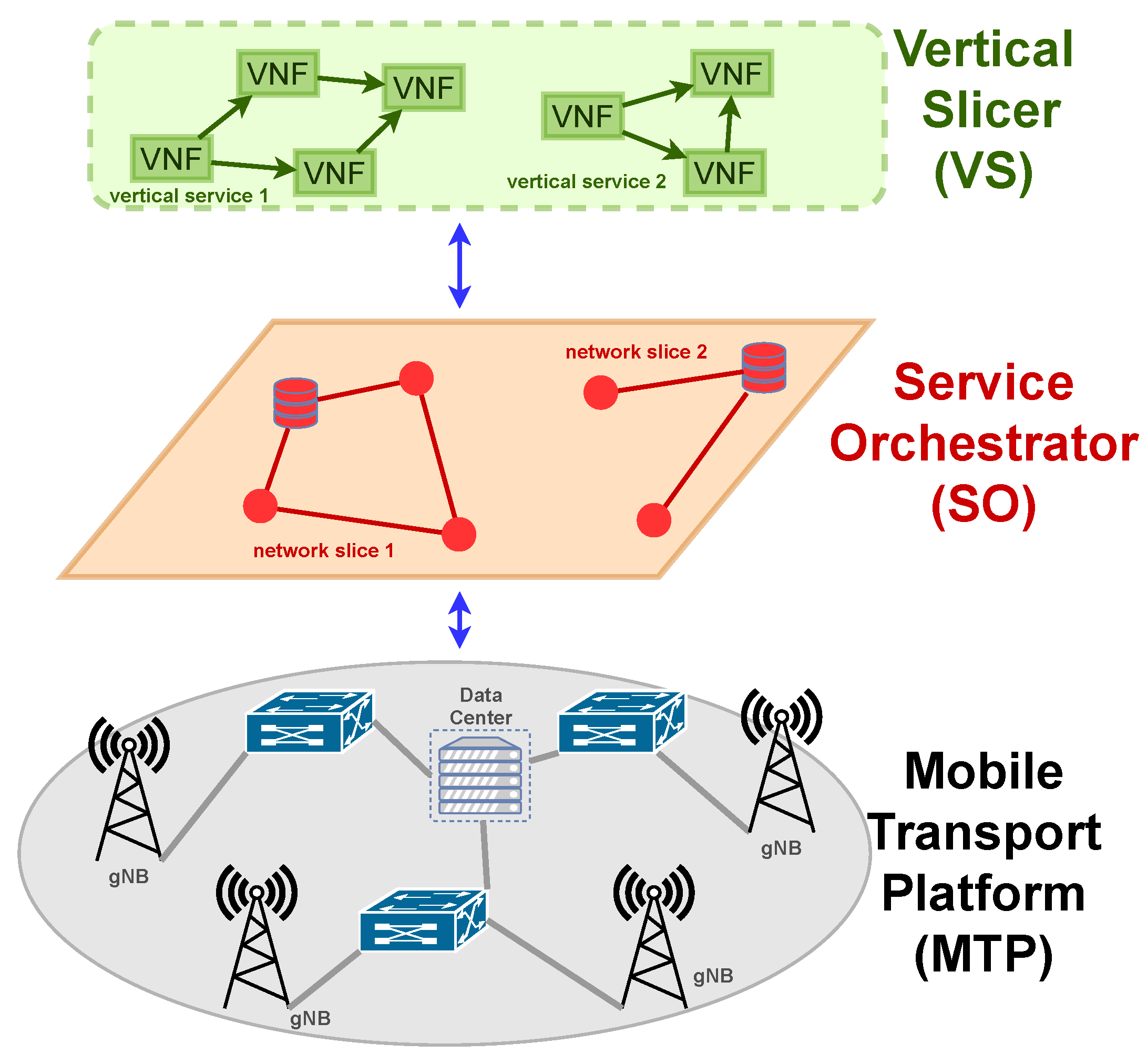

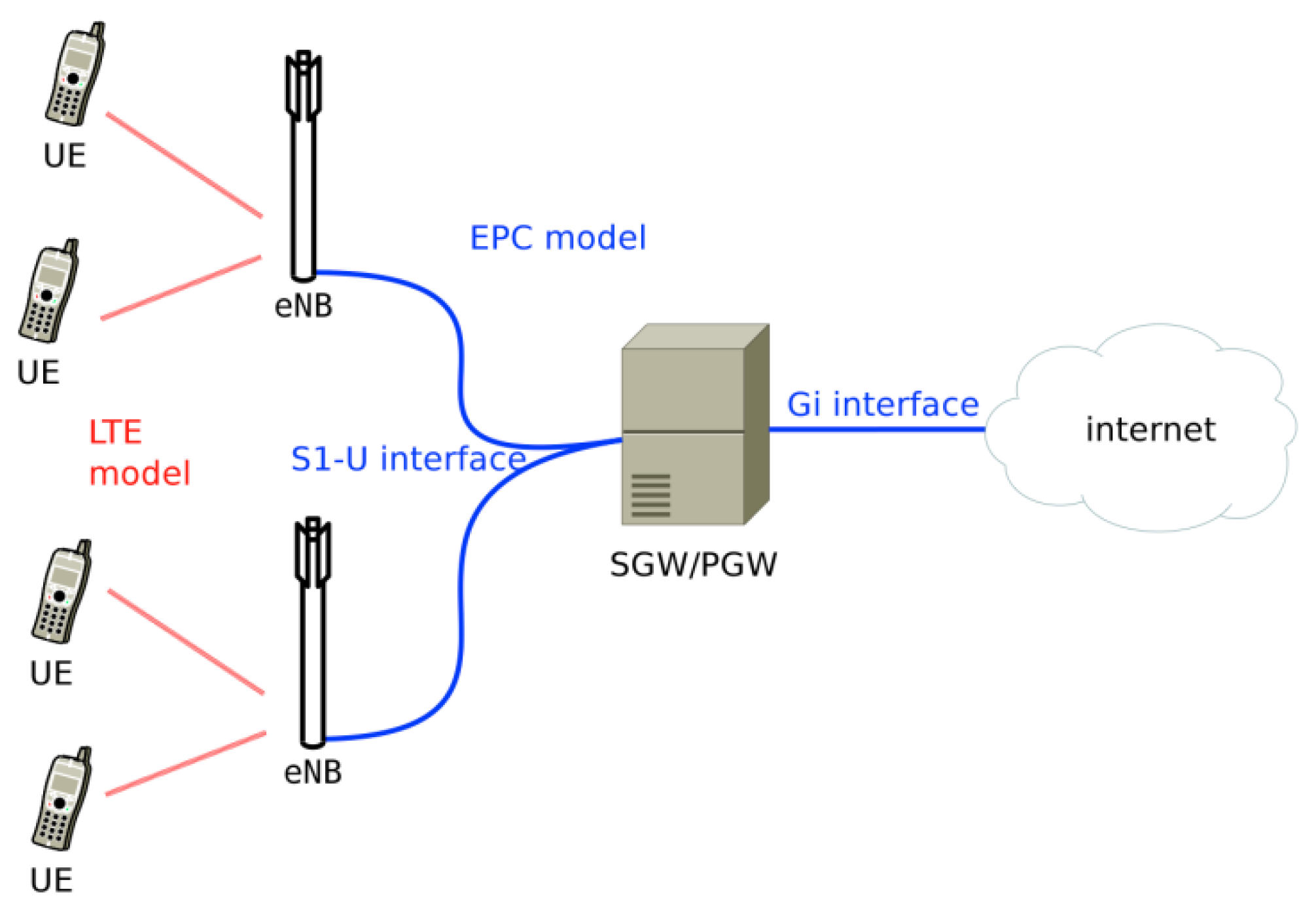

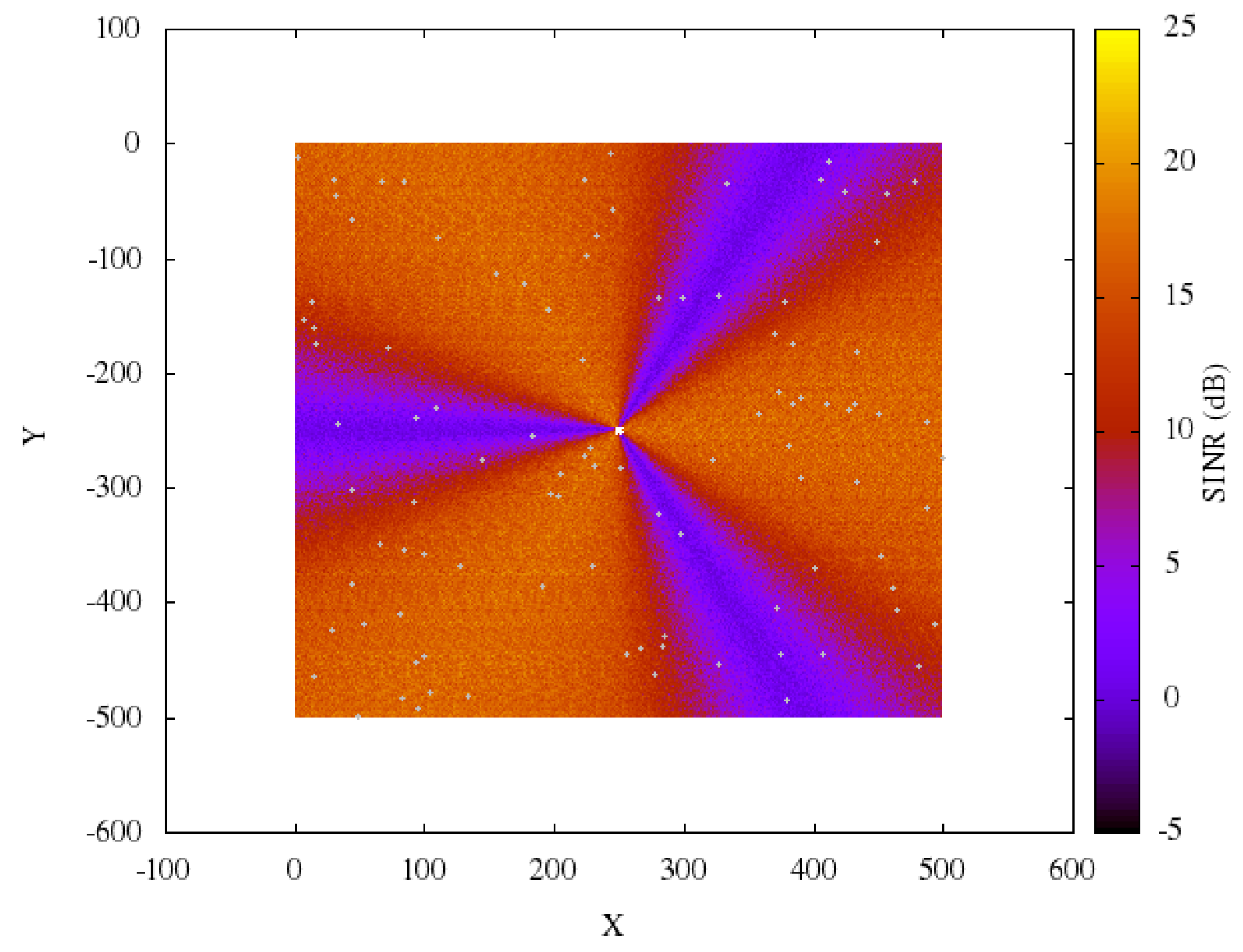
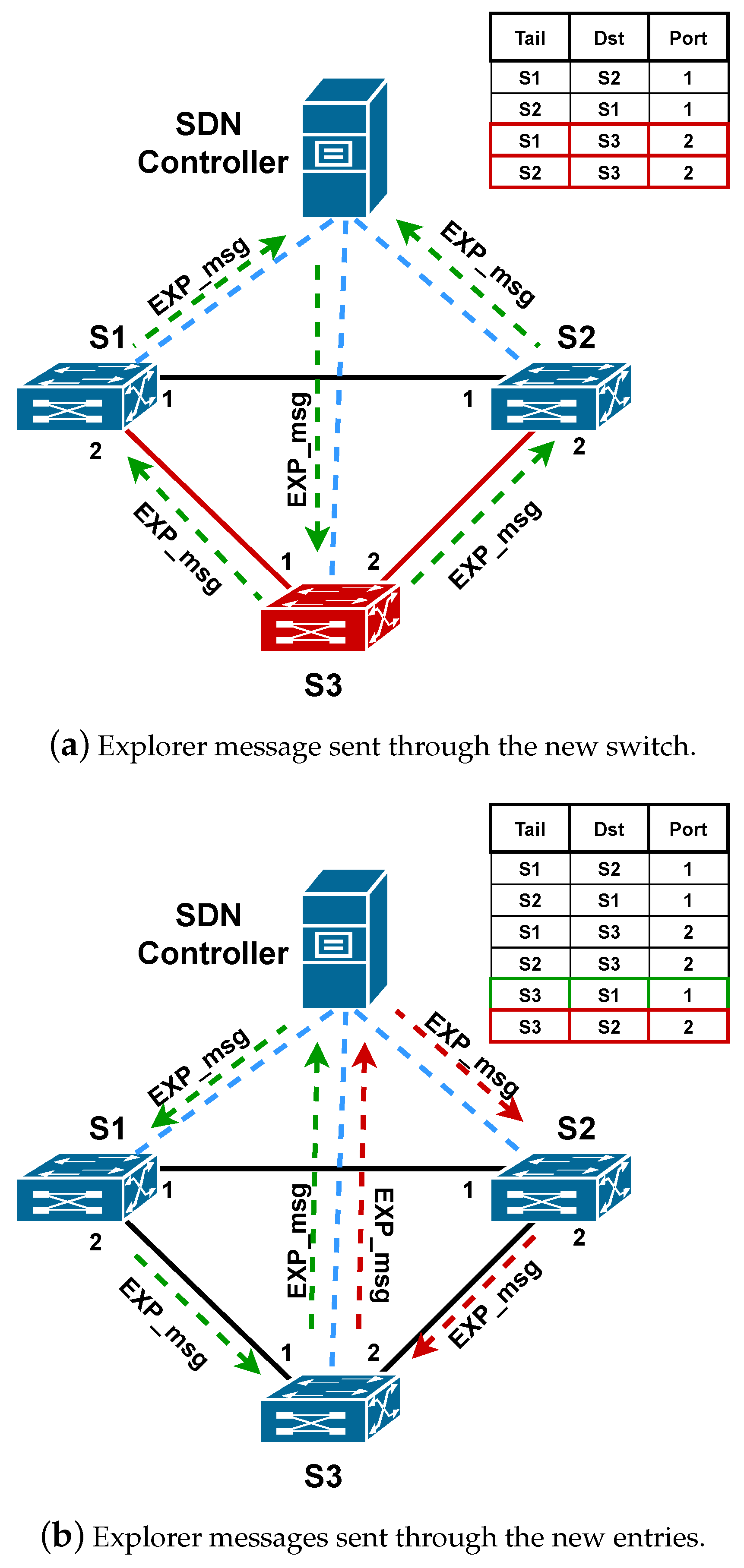
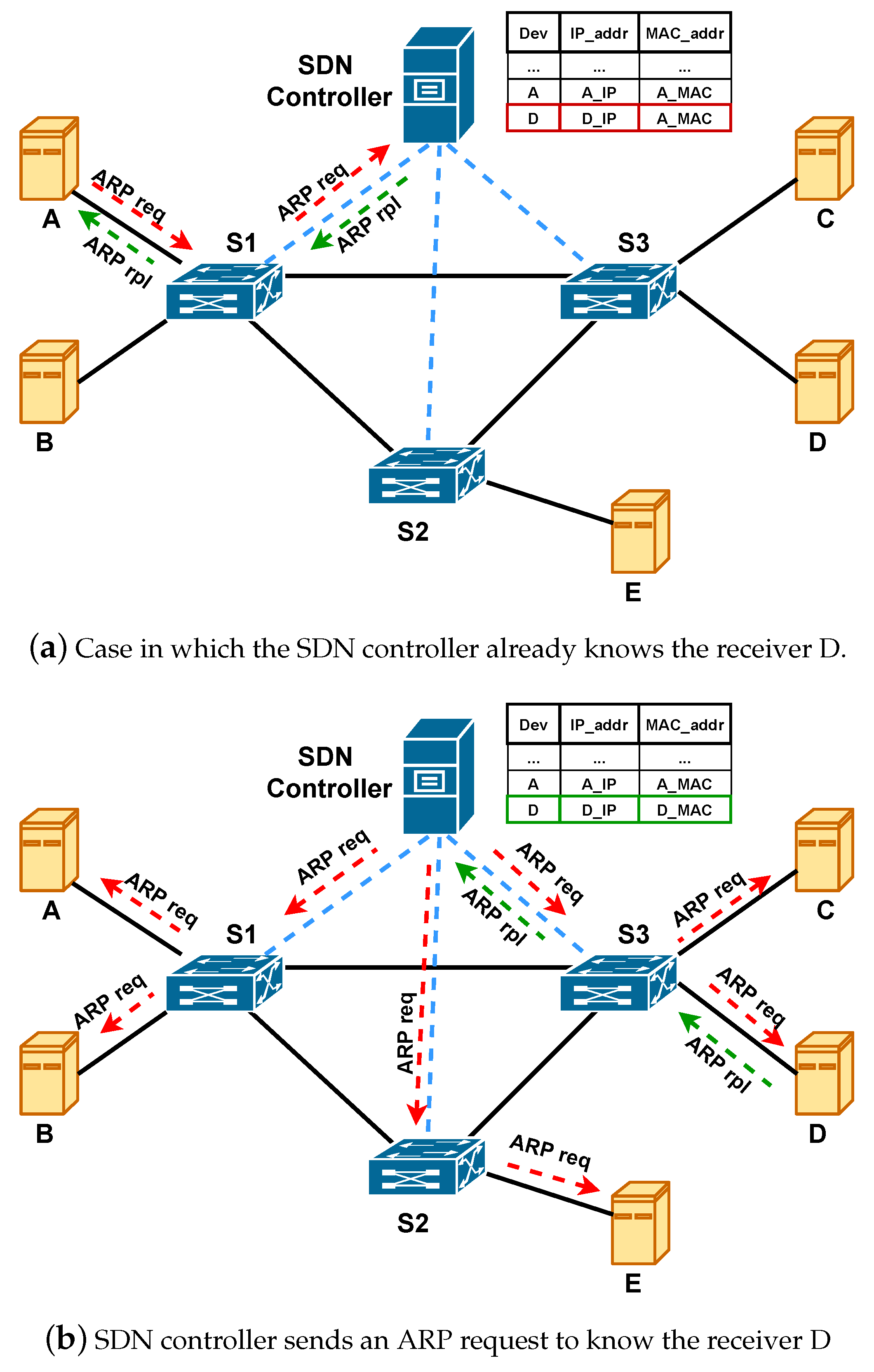
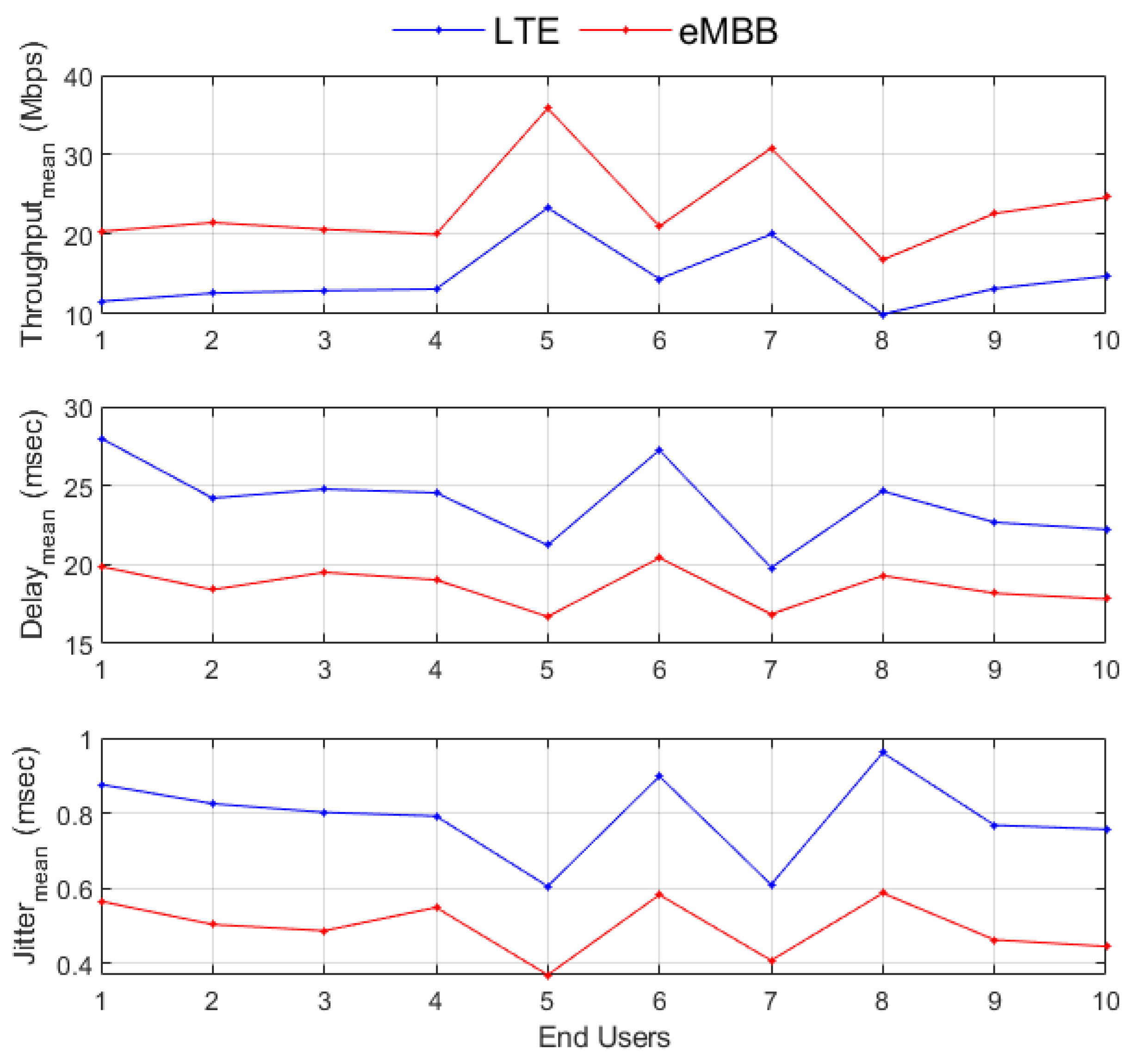
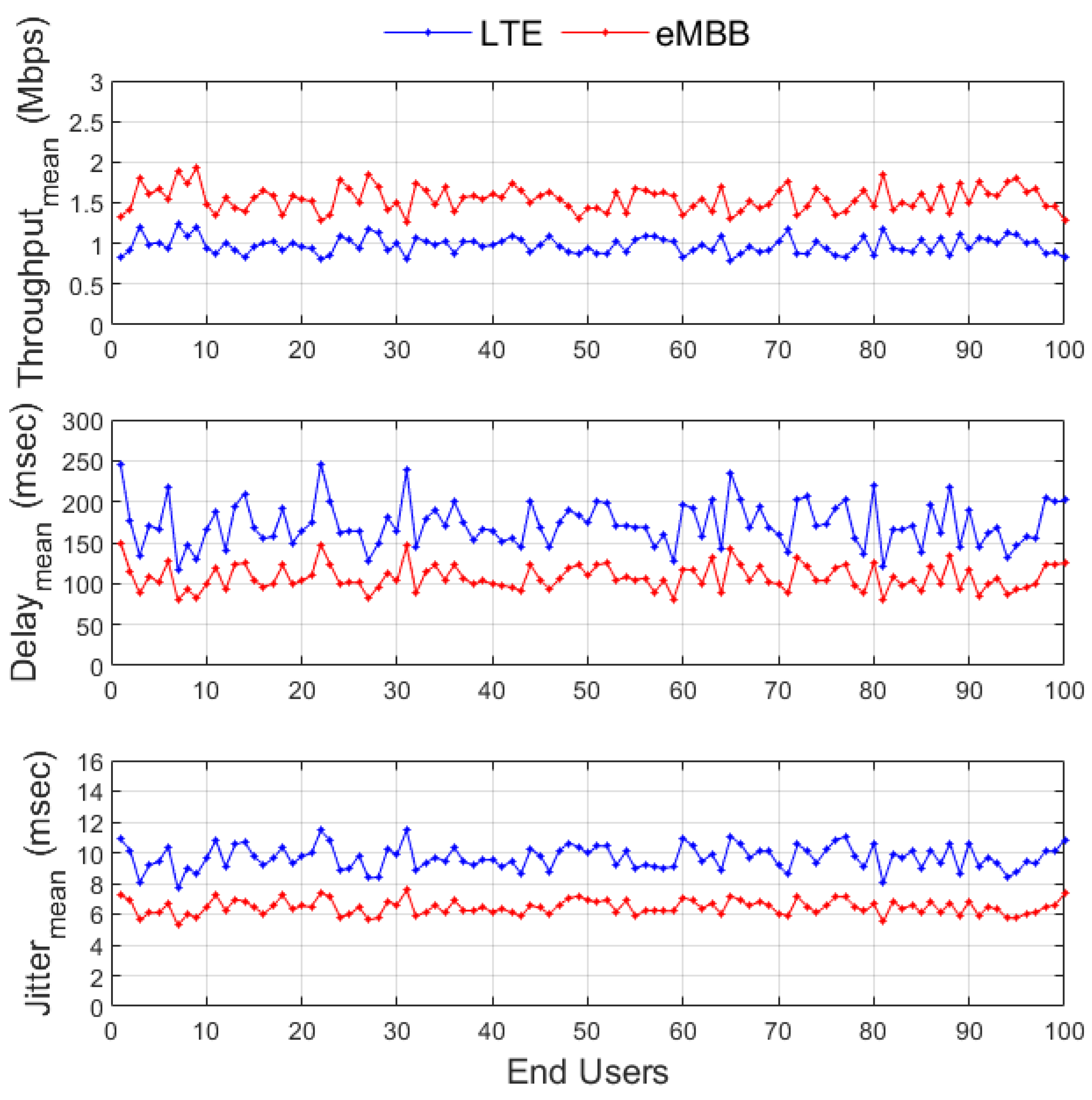
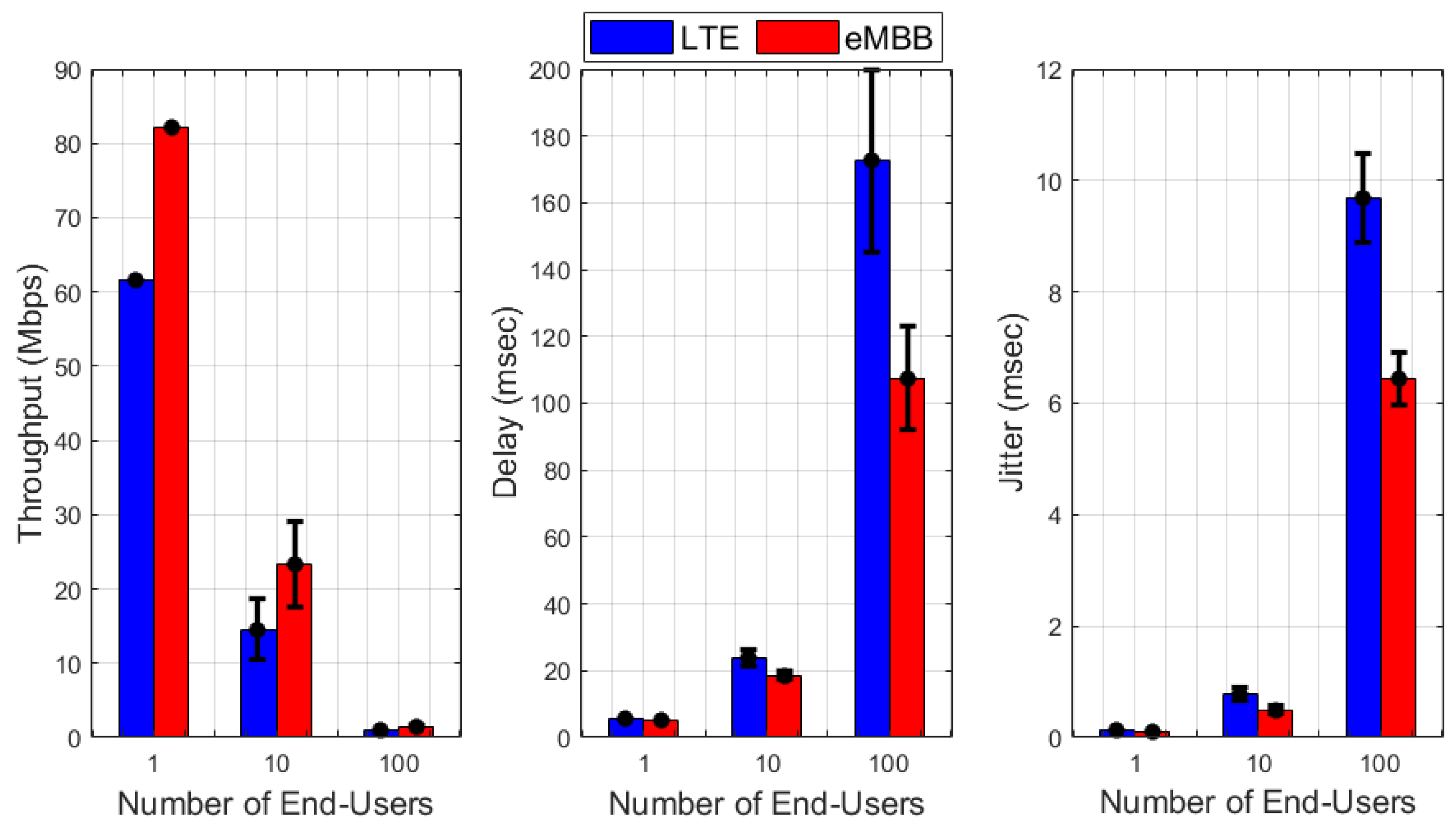

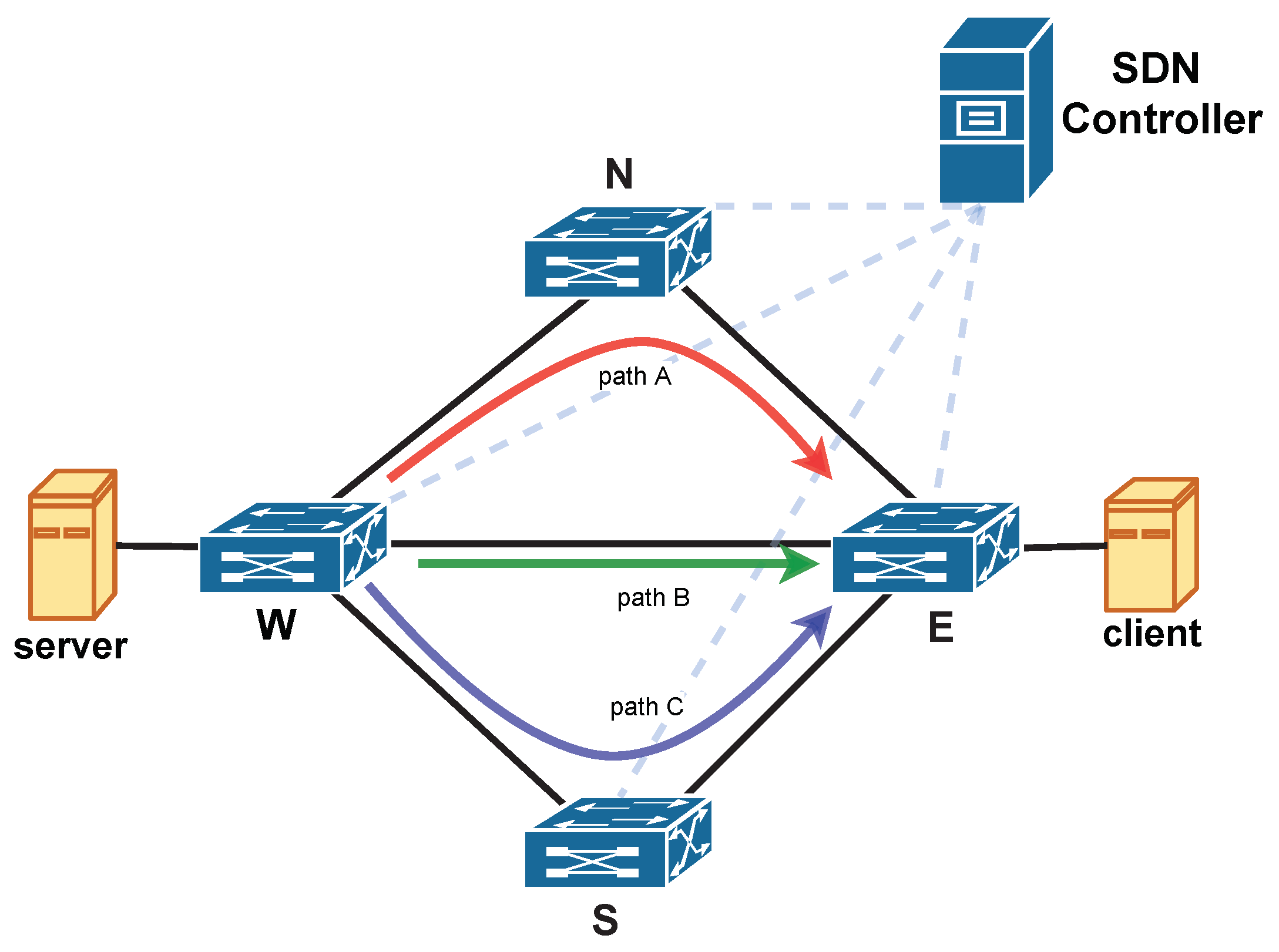

| Routing Strategy | Delay (s) | Jitter (s) |
|---|---|---|
| Alternate Paths | 242.490 | 0.000 |
| Load Balancing | 215.155 | 54.670 |
| Weighted Paths | 189.179 | 54.879 |
| Routing Strategy | Delay (s) | Jitter (s) |
|---|---|---|
| Alternate Paths | 242.490 | 0.000 |
| Load Balancing | 215.050 | 54.879 |
| Weighted Paths | 187.611 | 54.879 |
© 2020 by the authors. Licensee MDPI, Basel, Switzerland. This article is an open access article distributed under the terms and conditions of the Creative Commons Attribution (CC BY) license (http://creativecommons.org/licenses/by/4.0/).
Share and Cite
Lavacca, F.G.; Salvo, P.; Ferranti, L.; Speranza, A.; Costantini, L. Performance Evaluation of 5G Access Technologies and SDN Transport Network on an NS3 Simulator. Computers 2020, 9, 43. https://doi.org/10.3390/computers9020043
Lavacca FG, Salvo P, Ferranti L, Speranza A, Costantini L. Performance Evaluation of 5G Access Technologies and SDN Transport Network on an NS3 Simulator. Computers. 2020; 9(2):43. https://doi.org/10.3390/computers9020043
Chicago/Turabian StyleLavacca, Francesco G., Pierpaolo Salvo, Ludovico Ferranti, Andrea Speranza, and Luca Costantini. 2020. "Performance Evaluation of 5G Access Technologies and SDN Transport Network on an NS3 Simulator" Computers 9, no. 2: 43. https://doi.org/10.3390/computers9020043
APA StyleLavacca, F. G., Salvo, P., Ferranti, L., Speranza, A., & Costantini, L. (2020). Performance Evaluation of 5G Access Technologies and SDN Transport Network on an NS3 Simulator. Computers, 9(2), 43. https://doi.org/10.3390/computers9020043






